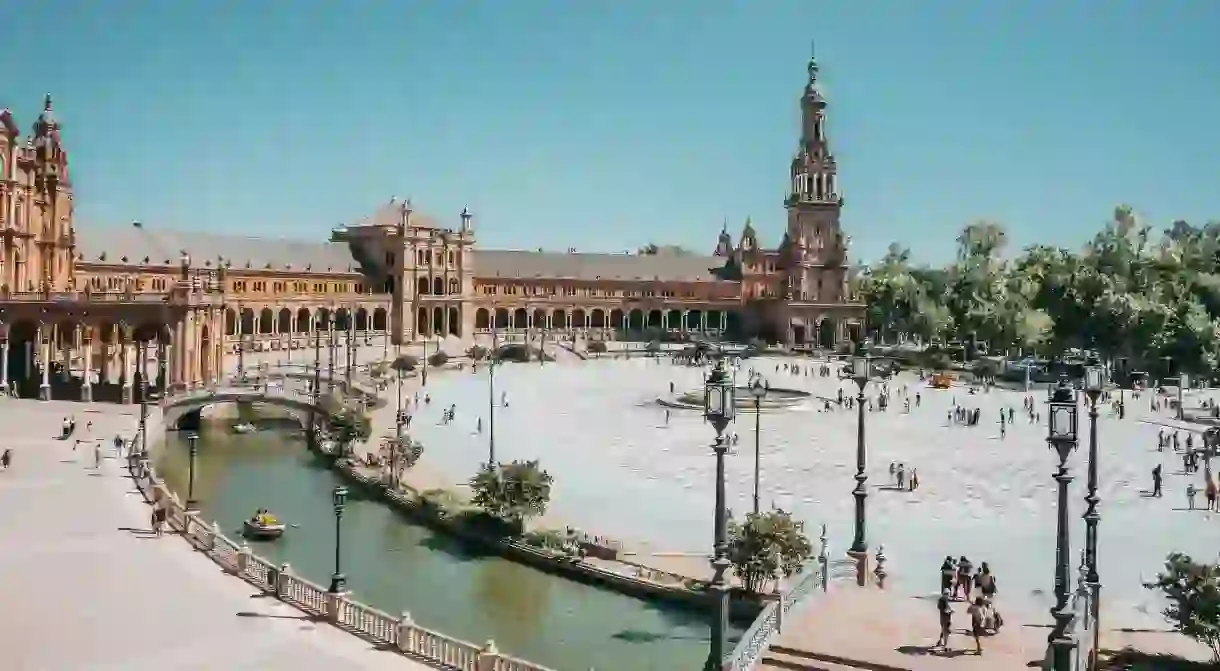Historical Monuments in Seville, Spain

Seville’s history is nothing if not grand, with the rise and falling of Islamic dynasties, conquests by Spanish kings and obscenely bombastic world fairs. Luckily, modesty wasn’t high on the agenda for Seville’s succession of rulers, and a great deal of showing off has left the Andalusian capital with some truly spectacular monuments. Though some date back as far as the 10th century, they’re remarkably well-preserved, meaning you can get a real glimpse into Seville of the past. Here are some historical monuments you have to see.
La Giralda
Cathedral
Nothing symbolises Seville’s architectural blend better than the Giralda bell tower. Now part of the celestial cathedral, it was once the minaret that crowned the Great Mosque of Seville during the Almohad dynasty. As is the city’s signature charm, it marries Moorish and Catholic influences to wondrous effect. Find the tower on Avenida de la Constitución in central Seville. While you’re here, make sure to see the inside of the cathedral, which is more than worth the €9 (£8.15) entry fee.
Torre del Oro of Seville
Museum
Among Seville’s most famous landmarks, the Torre del Oro (Gold Tower) is named after the glow it casts across the Guadalquivir River. Originally a watchtower of the 13th-century Almohad caliphate, the steely fortress has served as many things; currently, it’s home to an insightful maritime museum. It’s open all week and has a €3 (£2.70) entry, with concessions available.
Metropol Parasol
Building, Cathedral
Among the world’s largest wooden structures, this mushroom-shaped spectacle is also Seville’s most controversial monument. Loved by some and loathed by many, the bizarre undulating creation brings a touch of the modern into Seville’s historic streets. Its enormous canopy covers recently discovered Roman and Moorish ruins, housed in the Antiquarium museum beneath. Head up to the top for some staggering vistas. Entry is €5 (£4.50).
Parque de María Luisa
Botanical Garden, Museum, Park
In the run-up to the 1929 Ibero-American Exposition, south Seville had a huge makeover. This park became a monumental focal point, and it still carries the same attention-grabbing features. Among the promenades, ponds and botanical gardens, you’ll also find monument after monument; look for one to writer Miguel de Cervantes. The park is also home to the incredible Plaza de España. Its opening hours change depending on the season.
Real Alcázar de Sevilla
Building, Cathedral, Historical Landmark
You don’t want to leave Seville without seeing the magnificent royal palace complex. Constantly embellished and tweaked since its construction in 913, it is now a labyrinth of sumptuous delight, with Renaissance and Mudéjar architecture marrying to form one of the world’s most opulent functioning royal palaces. Long queues are unavoidable, but you can cut waiting time by making a booking. Entry is €11.50 (£10.40) for adults and free for children.
Plaza de España
Building, Memorial
No expense was spared in the making of architect Aníbal González’s astonishing plaza, by far the most lavish leftover of the 1929 Ibero-American Exposition. A wonderland of mini Venetian bridges, ecstatic fountains and ceramic walls, it resembles something from a big-budget Disney film. Its sheer enormity is astounding, and it’s best seen from its curved moat. Rent a boat for €6 (£5.45) for 35 minutes. Find the plaza in the Parque de María Luisa.













